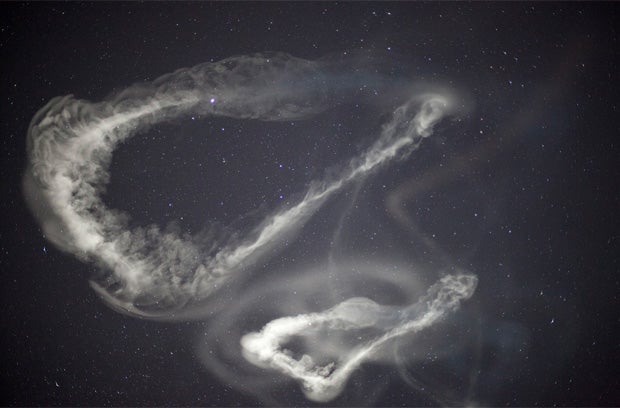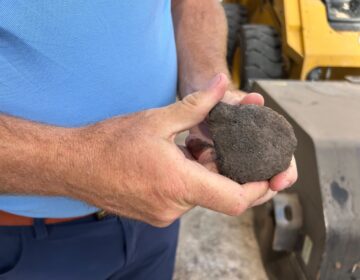Catch a closer-to-home rocket launch
ListenThis Friday night, NASA’s Lunar Atmosphere And Dust Environment Explorer is scheduled to launch from the Mid-Atlantic Regional Spaceport in Wallops Island, Virginia. Viewers in the Philadelphia area might see the event about 1 minute, 20 seconds after launch and 15 degrees above the horizon by observing to the south east from a clear southwest view location, but your best bet is go look from the South Jersey/Delaware beaches. It will appear as a small bright flame in binoculars. You’ll see more as you move down the Delmarva peninsula on the ocean side. This is the first of many larger launches to occur from MARS that could be visible from our area.
LADEE is a robotic mission that will orbit the moon to gather detailed information about the lunar atmosphere, conditions near the surface and environmental influences on lunar dust. It is the first deep-space mission to launch from NASA Wallops Island Facility. Rosh Hashanah begins Wednesday at sunset; the Jewish New Year is tied to the lunar calendar as the date is fixed as the sunset of the young moon’s appearance closest to the autumn equinox.
September 2, 2013
[Dave Heller] A NASA launch this week offers great viewing opportunities, and there’s no need to travel to the Kennedy Space Station to catch it. Let’s look aloft with Derrick Pitts, chief astronomer at the Franklin Institute. And Derrick, I’m heading to the Jersey Shore for this one.
[Derrick Pitts] Cape May would be an ideal location to try and get a view of this next launch vehicle that will be launching from what used to be called the Wallops Island Flight Facility, belonging to NASA. This is a location south of Chincoteague Island, where NASA has been launching sounding rockets — atmospheric sounding rockets — for decades. Just decades! And these are usually very small rockets, very narrow in size, not very much, but they were ways of testing our atmosphere. And many of our listeners may remember having seen multicolored clouds in the evening sky. And the multicolored clouds are the result of non-toxic chemicals that scientists put into the high atmosphere in order to map atmospheric currents.
-

NASA image captured March 27, 2012: NASA successfully launched five suborbital sounding rockets this morning from its Wallops Flight Facility in Virginia as part of a study of the upper level jet stream. The first rocket was launched at 4:58 a.m. EDT and each subsequent rocket was launched 80 seconds apart. Each rocket released a chemical tracer that created milky, white clouds at the edge of space. Tracking the way the clouds move can help scientists understand the movement of the winds some 65 miles up in the sky, which in turn will help create better models of the electromagnetic regions of space that can damage man-made satellites and disrupt communications systems. The launches and clouds were reported to be seen from as far south as Wilmington, N.C.; west to Charlestown, W. Va.; and north to Buffalo, N.Y. Credit: NASA/Wallops
This venture will be testing the atmosphere as well, though it’s not our atmosphere?
And you’re absolutely right. That’s the really cool thing about the launch coming up is that this is a launch of a spacecraft that’s going out to the moon to look at the moon’s atmosphere, try to get a better handle on what atmosphere there is there, and also look at the dust environment on the surface of the moon. The probe is called LADEE, and that’s the acronym for the Lunar Atmosphere Dust Environment Explorer sensing mission. And so the spacecraft will launch from this location this Friday night at about 11:27 p.m. And if you’re far south enough on the Jersey coast, Cape May, you’ll be able to see this launch looking out to the south-eastern portion of the sky. And you’ll be able to see it possibly about one minute after the launch time. It’s about that time that it will have reached enough altitude that from Cape May you can see it. And, it’ll be about 20 degrees above the horizon. It’ll be rising up and out of the atmosphere. And if you’re even farther south, down toward Chincoteague and Assateague Island, you’ll be able to see it even better. You’ll see it higher in the sky, and you’ll see it closer to the launch time.
How would one distinguish it from, say, a meteor shower?
Moving with determination! Meteors tend to flash very quickly for just a second or two, the longest ones are maybe three or four seconds. This you’ll be able to watch for minutes at a time and it’s a rocket engine that has some pretty good thrust to it, so it should be visible with a pair of binoculars without much difficulty.
Tell us more about the scope of the Mid-Atlantic Regional Spaceport.
Well as we mentioned earlier, they had been doing sounding rockets before — small, atmospheric rockets. Now what’s happening is that the Mid-Atlantic Regional Spaceport is gearing up to do much heavier launches. So this spacecraft is the beginning of that, and in fact, two companies — Orbital Sciences and Space Axe — have contracts over the next 3-4 years to launch about 20,000 pounds of cargo up to International Space Station over 20 launches, launching from this location. So since they’re going to be launching so much, it means that we’ll be able to see these launches on a fairly regular basis and when I say so much weight that they’re sending up as payload will require a pretty good-sized booster. So this means that whenever these launches take place, if we’re Cape May or further south, we’ll be able to see the launches. Now you actually can go to the Wallops Island Flight Facility and sit not far away — just a few miles away — to get a good view of the launch from a nearby state park. So that might be a great opportunity to take the family down, let’s say, while you’re down there in that beautiful area doing something else.
-
Antares Launch at Wallops Island Flight Facility- April 21, 2013
Are there regional spaceports across the country now?
They’re starting to develop across the country; so this is the Mid-Atlantic Regional Spaceport, there’s a regional spaceport out in New Mexico from which the Virgin Galactic spacecraft will be launching as well as other space vehicles carrying tourists up to low-Earth orbit. Kennedy of course is still launching. And there are a number of other sort of interesting launch locations — there’s a launch location in Alaska, there are launch locations in California (the Air Force keeps as a launch location), and actually there’s one private company that has a mobile launching platform that is towed out to the mid-Pacific ocean to launch vehicles from there.
Now again, specifically this mission will be going to the moon and checking out its atmosphere looking for water? On the moon?
It’d be great if it could find some water on the moon because in fact, just recently, a group of scientists have reexamined data from more recent lunar exploratory craft and have also looked at the data again from the first moon rocks brought back from the moon. And the reason why is because with new analytic techniques, these scientists have been able to determine that there is actually much more water in the lunar rock than we ever imagined was there. When we first looked at the lunar rocks coming back from the moon, the signatures of water molecules that we saw we thought were probably a contamination from the Earth’s atmosphere. As it turns out, when we reexamine these rocks with new techniques, and other sensing techniques we now have available from lunar orbit, on platforms in lunar orbit. We can actually see that there IS water molecules, there are water molecules, in the lunar rocks. So we’re looking at one particular mineral in the lunar rocky material called norite. And norite shows its signature of water molecules but it’s a really interesting way that it shows it It’s not as if we’re looking at a river or a stream or anything like that; we’re looking at natural processes from when the rock formed as magma coming to the surface after a meteorite impact. So when a meteor strikes the surface of the moon, becomes a meteorite if it becomes large enough it can liquify the surface immediately underneath where it impacts, and we see that the norite material coming up from the interior of the moon has water molecules in it. This looks just like a normal kind of magma signature of water like we would find here on Earth, or Earth rocks.
But again, we’re talking molecules, not even droplets.
Not even droplets. So we can’t expect to go there to make a stop to fill up our thermos bottles on our way to Mars.
Derrick, this week marks the advent of Rosh Hashanah, the Jewish New Year; it’s also tied to the lunar calendar.
Indeed it is. Like so many other religious celebrations, Rosh Hashanah, which begins Wednesday at sunset, is tied to the lunar calendar. As it turns out, it’s the date that’s fixed as the sunset of a young moon’s appearance closest to the autumnal equinox.
Well on this Labor Day I’m not quite ready to acknowledge autumn yet, we’ll talk about that in weeks to come.
WHYY is your source for fact-based, in-depth journalism and information. As a nonprofit organization, we rely on financial support from readers like you. Please give today.




